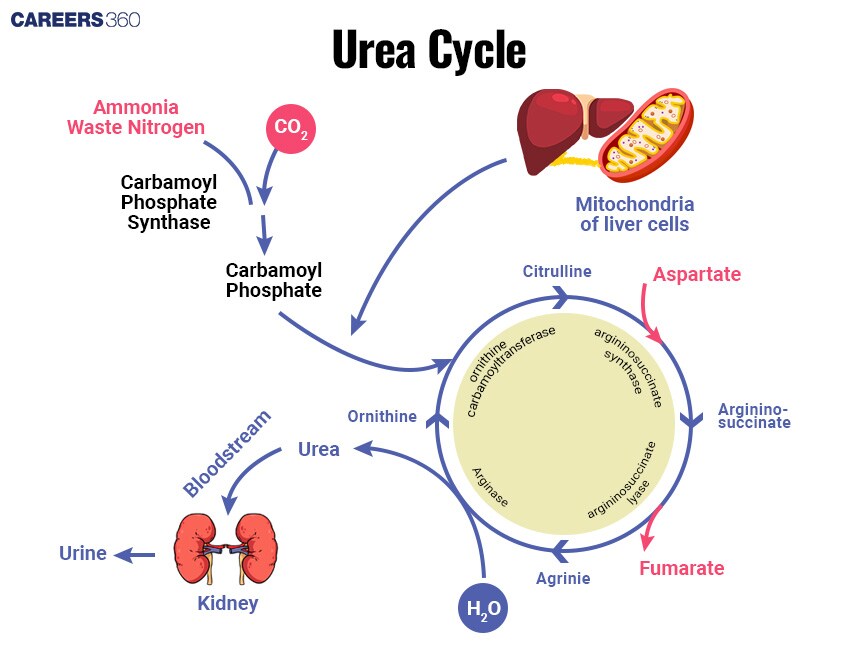Urea Cycle (Krebs Henseleit Cycle): Steps, Significance And Importance
What Is The Urea Cycle?
The urea cycle is the metabolic process by which toxic ammonia is converted into urea, which the kidneys can excrete safely. Because of this, it plays a very important role in detoxifying ammonia which is the byproduct of protein metabolism and in maintaining nitrogen balance in the body. The cycle works through the concerted actions of several key enzymes and intermediates for the conversion of ammonia to urea.
The discovery of the urea cycle was made in 1932 by Hans Krebs and Kurt Henseleit. This breakthrough gave very substantial insight into detoxification mechanisms for ammonia and nitrogen metabolism. Their work founded the base from which the understanding of metabolic diseases related to the urea cycle has grown and has thus driven medical research and advancement in treatment for related disorders.
Detailed Explanation Of Urea Cycle
The urea cycle is one of the most important metabolic pathways taking place in liver cells, showing the conversion of highly toxic ammonia to urea, which later will be excreted. It does so through many enzymatic reactions occurring both in the mitochondria and the cytosol of liver cells.
Location Of the Urea Cycle
Cellular location: Mitochondria and cytosol of hepatocytes.
Tissue specificity: Mainly liver.
Steps Of the Urea Cycle
The detailed steps of the urea cycle are given below:
Carbamoyl Phosphate Synthetase I
Carbamoyl phosphate formation from ammonia and bicarbonate
Activation by N-acetylglutamate.
Ornithine Transcarbamylase
Conversion of carbamoyl phosphate and ornithine into citrulline.
Argininosuccinate Synthetase
Formation of argininosuccinate from citrulline and aspartate.
Argininosuccinate Lyase
Cleavage of argininosuccinate into arginine and fumarate.
Arginase
Hydrolysis of arginine into urea and ornithine.
Recycling Of Ornithine
Transport of ornithine back into the mitochondria for recycling in the cycle.

Biochemical Pathways And Intermediates
The cycle comprises different significant intermediates and enzymes involved in the pathway of conversion of ammonia to urea.
Key Intermediates And Enzymes
The details are given below:
Carbamoyl Phosphate
It is synthesised from ammonia and bicarbonate.
Enzyme: Carbamoyl phosphate synthetase I.
Co-factor: N-acetylglutamate is required to activate carbamoyl phosphate synthetase I.
Citrulline
It is produced from carbamoyl phosphate and ornithine.
Enzyme: Ornithine transcarbamylase.
Moved from the mitochondria to the cytosol.
Argininosuccinate
Formed from citrulline and aspartate.
Enzyme: Argininosuccinate synthetase.
ATP is utilised in this step.
Arginine
Produced by the cleavage of argininosuccinate.
Enzyme: Argininosuccinate lyase.
By-product: During the reaction, fumarate is formed.
Ornithine
Product of arginine hydrolysis.
Enzyme: Arginase.
Ornithine is transported back into the mitochondria for further rounds of the cycle.
Mechanism Of Enzymes And Co-factors
The mechanism is described below:
Carbamoyl Phosphate Synthetase I
Condenses ammonia with bicarbonate in the presence of two molecules of ATP to form carbamoyl phosphate.
Co-factor: N-acetylglutamate acts as an essential activator.
Ornithine Transcarbamylase
Transfer of the carbamoyl group from carbamoyl phosphate to ornithine to form citrulline.
Co-factor: None specifically required.
Argininosuccinate Synthetase
Condenses citrulline with aspartate into argininosuccinate.
Co-factor: Requires ATP for substrate activation.
Argininosuccinate Lyase
Cleaves argininosuccinate into arginine and fumarate.
Co-factor: None specifically required.
Arginase
Hydrolyzes arginine to form urea while regenerating ornithine.
Co-factor: Requires manganese ions Mn²⁺ for its catalytic activity.
Regulation Of The Urea Cycle
The urea cycle is rather strictly regulated to provide an effective detoxification system for ammonia.
Allosteric Regulation
Role of N-acetylglutamate.
Mechanisms of feedback inhibition.
Genetic Regulation
Genes which encode the urea cycle enzymes.
Control at the level of transcription.
Physiological Regulation
Influence of diet and protein intake.
Hormonal influences: Glucagon and insulin.
Urea Cycle Disorder
The disorders associated with the urea cycle are:
Genetic Defects In The Enzymes Of The Urea Cycle
Symptoms and diagnosis of urea cycle disorders
Treatment: Dietary management, drugs
Hyperammonemia
Etiologies and effects of elevated blood ammonia levels
Acute and chronic management strategies.
Conclusion
This urea cycle is thus of vital importance as a mechanism of detoxification of ammonia and in maintaining nitrogen balance in the body. Their mechanisms, control and clinical significance therefore become of primal interest to any healthcare professional for the care and management of metabolic disorders and the advancement of medical research.
Recommended Video On ‘Urea Cycle (Krebs Henseleit Cycle)'
Frequently Asked Questions (FAQs)
N-acetyl glutamate serves as an essential activator of carbamoyl phosphate synthetase I, the first enzyme of the urea cycle.
The urea cycle's major role encompasses the detoxification of highly toxic ammonia into urea, which is then removed through excretion by the kidneys.
The cycle takes place in the mitochondria and cytosol of the liver cells, the hepatocytes.
Somnolence, vomiting, seizure, and in severe cases, coma resulting from hyperammonemia.
The breakdown of amino acids and other nitrogenous compounds results in the formation of ammonia.